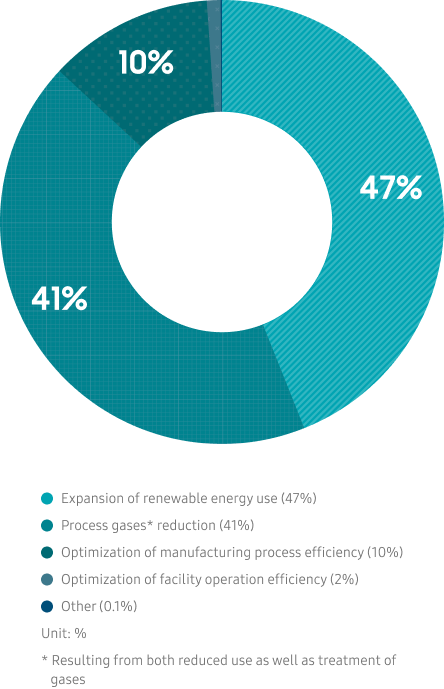Climate Action


2027 - Aim to match electric power needs with renewable energy in DX (Device eXperience) Division and all global operations sites
2030 - Aim to achieve net zero carbon emissions at the DX (Device eXperience) Division (Scope 1 & 2)
2050 - Aim to achieve company-wide net zero carbon emissions (Scope 1 & 2)
Samsung Electronics
is one of the world’s largest ICT (Information & Communication Technologies) manufacturing company that makes products in all areas of the electronics industry — from semiconductors to smartphones, TVs and home appliances.
RE100 cites* Korea, where many of Samsung Electronics’ production facilities are based, as one of the most challenging countries to source renewable energy. This is in part due to the country’s renewable energy market, where procurement options for corporations have begun to expand but remain limited. Additionally, the electric power needs of semiconductor manufacturing facilities have continued to increase with the expansion of Samsung Electronics’ production capacity to meet global demand. However, the company will aim to achieve renewable energy use more proactively, acknowledging the urgency of today’s climate challenges.
*Source: "Revealed: the most challenging places in the world for business to source renewable electricity" (RE100/Climate Group/CDP, 2020)
*Based on direct and indirect greenhouse gas
emissions of 17.4 million tonnes in 2021
(Annual greenhouse gas emissions of 2.1 tonnes per sedan, Korean Energy Corporation)

In 2022, through a total of 474 greenhouse gas reduction projects, we reduced greenhouse gases by 10.16 million tonnes per annum.

By using innovative technologies that significantly improve process gas treatment efficiency,
Samsung Electronics can keep direct carbon emissions (Scope 1) down even as production increases.
We aim to transition to
100% renewable energy by 2050
2018 - Declared to expand the use of renewable energy (100% in the U.S., Europe and China)
2020 - Transitioned to 100% renewable energy use in the U.S., Europe and China
2022 - Matched electricity use in Southwest Asia with renewable energy
2025 - Aim to match electricity use in Central and South America with renewable energy
2027 - Aim to match electricity use with renewable energy for all business sites(excluding Korea) and DX(Device eXperience) Division
2050 - Aim to match electricity use with renewable energy for all global operations
Continued carbon emission
reductions in upstream and
downstream operations
Manufacturing is only one of many stages in the entire product life cycle. We strive to reduce carbon emissions across all stages of the product life cycle including distribution, sales, and use in collaboration with our consumers, suppliers, and other stakeholders.
In particular, we plan to utilize ultra-power-saving technology for semiconductors, which is expected to drastically reduce the memoryrelated power consumption of data centers and mobile devices from 2025. We plan to apply the technology to the leading models of our seven major product categories (smartphone, refrigerator, washer, air conditioner, TV, monitor, and PC) and improve their power consumption by 30% by 2030 compared to the 2019 models with equivalent performance.
Energy efficiency of
products 1)2)
| 2020 | 2021 | 2022 | |
|---|---|---|---|
| Amount of GHG emissions reduced in the product use phase | |||
| Amount reduced by year (1K tonnes CO₂e) | 31,671 | 32,906 | 914(18,909)* |
| Energy efficiency improvement rate | |||
| Product energy consumption reduction rate (%) | 32 | 33 | 2.6(18)* |


We established the LCA process to accurately assess the
environmental impact and carbon footprints of our
semiconductor products across their entire lifecycles. Based
on ISO 14040, 14044, and 14067, the operation of this process
was verified by a third-party organization to ensure the
credibility of all data produced.
To reduce the environmental impact of semiconductor
products, we plan to establish a comprehensive management
system of their carbon emissions and their use of water and
other resources.